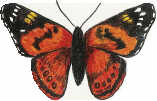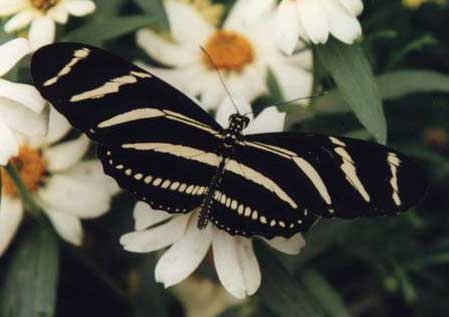Butterfly Search
The zebra longwing loves the passionflower (Passiflora sp.).
Check out this vine and see if you find all of the life stages of the butterfly:
- Egg: very small and yellow, the size of the head of a pin
- Caterpillar: white with several rows of black spines and spots
- Chrysalis or cocoon: looks like a dried up leaf
- Adult: black with yellow stripes
Look closely at the growing tips of the passion vine to see tiny zebra longwing caterpillars that have recently hatched from the egg.
Can you find caterpillars as small as this line? - (less than 1/4 inch)
See if you can spot some of the many butterflies that are frequent visitors to the Butterfly Garden:
Zebra Longwing, Sulphurs, White Peacock, Monarch, Skippers, Gulf Fritillary.
Some caterpillars are poisonous to predators and announce this with bright colors.
Can you find the brightly colored monarch or atala caterpillars?
(Hint: Look on the milkweed (Asclepias curassavica) and coontie (Zamia integrifolia).

Zebra longwings gather to sleep each evening at Senior Horticulturist Mary Collin's garden hammock.
One night she counted 26 zebras sleeping together in one area!
It is thought that they ‘roost’ in the same area (branch or branches) every night.
Butterfly Day at Fairchild
 |
| Painted Lady S. Knorr 2001 |
Sunday, July 30, 2006
9:30 am - 4:30 pm
Come to the world of butterflies at Fairchild.
Learn to identify South Florida's butterfly species and grow plants for your own butterfly garden.
Then take a butterfly tour through Fairchild with experts or buy butterfly plants.
Cosponsored by Fairchild and the Miami Blue Chapter of the North American Butterfly Association.
| 9 am - 1 pm | Veranda restaurant open for Pancake Breakfast |
| 10 am -3 pm | Kids Activities |
| All day | Butterfly plants for sale |
| Butterfly Talks: Garden House |
|---|
| 9:30 | Butterflies & Butterfly Watching in So Florida | Elane Nuehring |
| 10:15 | Lifestyles of Butterflies in the Garden | Alana Edwards |
| 12 noon | Butterfly Plant Doctors/Walk-in Clinic | Linda Evans & Sam Wright |
| 12-1 pm | Book signing | Jeffrey Glassberg & Roger Hammer |
| 1 pm | Meet So Florida's Best Loved but Little Known Bugs: the Butterflies | Jeffrey Glassberg |
| 2:30 pm | Butterfly Groceries: the Larval Host and Nectar Plants in South Florida | Roger Hammer |
| 3:45 pm | Annual July Count of FTBG Butterflies | Elane Nuehring |
| Butterfly Walks |
|---|
| 10:15 am | Field Trip for the Intrepid: Keys Coastal Habitat & Pinelands Walk |
| 11:30 am | Butterfly Observation in the Butterfly Garden & Vine Pergola |
| 2 pm | Lisa Anness Butterfly Garden Dedication |
Butterflies at the Garden
Gillian Drake, Youth Education Manager
Visit the Butterfly Garden
Head towards the chickee in the Learning Garden, and you will find a colorful little garden
that has been attracting flying visitors since it was planted in April 2001.
In this garden, many species of butterflies find the plants they need for nectar and hosts for their larvae.
A quiet, patient visitor may see a variety of butterflies, and discover all four life stages of a butterfly.
Under the guidance of staff from the Horticulture and Education departments,
and with Florian Fiebig's leadership, Scout Troop 457 developed the garden.
Many plants were kindly donated by Natureland Nursery; the children in the L.E.A.F. (Let's Explore At Fairchild) program helped plant them.
This young garden has grown tremendously in the last year.
It offers visitors to Fairchild Tropical Botanic Garden a wonderful spot to observe interactions of plants and animals.
When you visit, please enjoy the plants and the butterflies, but don't try to catch butterflies.
Although they are very fast and hard to catch, if you did succeed, you could damage their delicate wings.
Children who love butterflies, games, puzzles and activities should look up "Club caterpillar for kids" at the following website:
www.milkweedcafe.com/ClubCathome.htm.
 |
| Monarch S. Knorr |
How well do you know butterflies?
(Answers Below)
- A caterpillar's first food is usually
- a leaf
- its own eggshell
- nectar from a flower
- Water will damage the wings of butterflies.
- true
- false
- Approximately how many different species of butterfly live in the United States and Canada?
- 780
- 1200
- 5000
- Butterflies cannot fly if the temperature is
- below 50 degrees Fahrenheit
- below 60 degrees Fahrenheit
- below 70 degrees Fahrenheit
- What is the state butterfly of Florida?
- monarch
- sulphur
- atala
- zebra longwing
An Easy Life?
There is something about butterflies that seems to make everyone feel joyful.
How beautiful and carefree they appear, lightly dancing from flower to flower, barely pausing to lay an egg on newly emerging foliage.
They lift our spirits with their apparent ease of living.
But in truth, the life of a butterfly is anything but easy and carefree.
Consider the zebra longwing.
From the moment of hatching, the caterpillar has only one purpose in life: to eat.
Feeding continuously, the caterpillar grows quickly, bursting through layer after layer of skin (molting).
Once the eating machine has reached maximum capacity, it attaches itself to a leaf with a silken string
and hangs upside down to prepare for one of the greatest feats in nature.
Inside a chrysalis that is disguised as a dried up leaf, the caterpillar completely liquifies and then reassembles itself as an adult butterfly.
After about nine days, the delicate new butterfly is ready to emerge from its cocoon.
For female zebra longwings, this is not an easy task.
Hovering over her chrysalis are male butterflies, fighting off one another in the hopes of mating with the female as she emerges,
or even before she emerges.
At first emergence from the chrysalis, the wings of the butterfly are like soggy paper and it cannot fly.
Fluids from the butterfly's body are pumped into the wings, and after a few hours they are stiff enough for the butterfly to fly.
From this time on, the butterfly exists solely to reproduce.
A female zebra may lay up to 1,000 eggs, surviving on only flower nectar and a little pollen.
Many do not survive long enough to pass along their genes.
The list of butterfly predators includes frogs, snakes, birds, spiders, reptiles, small mammals.
The entire life from egg to adult can be as short as 21 days.
By then, eggs are hatching and the cycle starts again.
Garden Views Autumn 2002

Answers to quiz above
1, b; 2, b; 3, a; 4, b; 5, d
![]() Teachers
Teachers
![]() Adults
Adults



